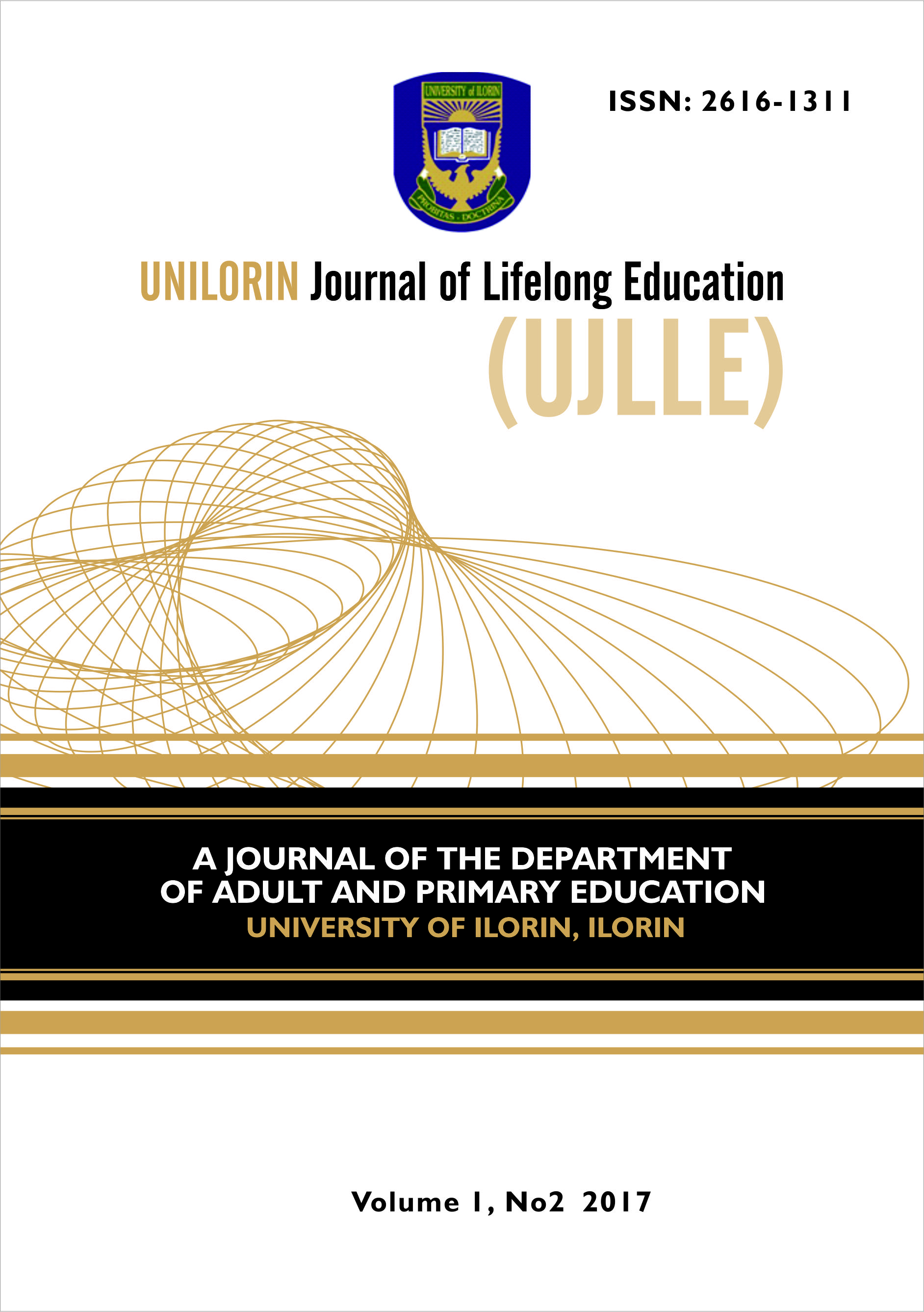AN ASSESSMENT OF THE CREATIVITY LEVEL OF SECONDARY SCHOOL STUDENTS IN LOKOJA, KOGI STATE, NIGERIA
Keywords:
Creativity, Problem-solving ability, Creative ability, Creative thinkingAbstract
The main aim of this study was to examine the creative ability among secondary school students in Lokoja. A descriptive survey was adopted for the research. A total of 400 students participated in the study. A research question was answered and two hypotheses were tested at 0.05 level of significance. Percentage and t-test Analysis were the statistical tools employed for the study. From the data analyzed and results gathered, it was observed that the creativity level of secondary school students in Lokoja, Kogi State is low, because only 5% had high level of creativity which is not up to average of the students that participated in the study in Lokoja, Kogi State. The findings also revealed that there is significant difference in creativity level of male and female students. Finding also revealed that there is significant difference in the creativity level of private and public school students. Based on the findings of the study, more attention should be given to the students by educational psychologists, parents, teachers, and school administrators. They should not only to be concerned about academic success of the students, but also their creative abilities and creative achievements in school. With this, students will attach importance to creativity as they do to their primary purpose in school. Teachers should allow students to use their divergent thinking, which promotes creativity, instead of convergent thinking which only promotes rote learning. Government and school proprietors have enormous roles to play in creative development. They should further integrate games and play into education. Play has a central role in the creative process. In addition, the enjoyment factor involved in games has the potential to greatly enhance motivation and interest in students, thereby opening doors for flow of creativity. The Nigerian government should ensure that educational psychologists and career counselors are provided at all levels of education.
References
Abra, J. & Valentine-French, S. (1991). Gender differences in creative achievement: A survey of explanations. Genetic, Social, and General Psychology Monographs, 117, 235-284.
AdamsPrice, H. (1998). Family positions and the attainment of eminence: A Study of special family experiences. Gifted Child Quarterly, 24(2), 87-95.
Adebimpe, G. K. (1986). Personality and biological markers of creativity. European Journal of Personality, 19(2) 83-95.
Adebowale, N. O. (2001). Refining culture through creative arts. Lagos: School of vocational and technical education (AOCOED), Lagos.
Adeshina, S. C. (1980). National policy on Education: Formulation and Implementation, in: Tamuno, T. N. &Atanda, J. A. (eds), Nigeria Since Independence (Heinemann Education Books Nigeria limited).
Avdhesh, S. J. (2013).A study of Creativity of the high School Students in Relation to Certain Variables. Voice of Research, Vol. 1.
Baer, J. (2005). Gender differences. In M. A. Runco& S. R. Pritzler (Eds). Encyclopedia creativity (Vol. 1 pp. 753-758). San Diego, CA: Academic press.
Chen, V. N. (2007).Guiding creative talent. Englewood Cliffs, NJ: Prentice Hall.
Edward de Bono (2001) Encyclopedia of Human Behaviour (New York: Academic Press Inc).
Feist, K. & Runco, M. A. (1998).Individual differences in creativity: Personality, story writing, and hobbies. European Journal of Personality, 15(4), 297-310.
Freeland, N. L. & Moran, H. (1987).Self, Identity, and emotional well-being among Turkish University students.The Journal of Psychology, 138(5), 457-478.
Harrigto-Lukas, L. O. (1997). Building academic success on social and emotional learning: What does the research say? New York: Teachers College Press.
Kaufman, J. C., Baer, J., & Gentile, C. A. (2005).Differences in gender and ethnicity as measured by ratings of three writing tasks. Journal of creative behavior, 38(1), 56-69
Kim, L. U. & Micheal, K. (1995).Piers – Harris Children’s self – concept scale. Los Angeles, CA: Western Psychology Services.
Linda, S. (2010). Creativity at work; articles & tips. Retrieved 08/07/2010 from http://www.creativityatwork.com/articles scontent/whatiis.htm.
McCormick, D. J. & Plugge, C. D. (1997). “If I am an artist, what’s wrong with my picture”? In deeply rooted, branching out 1972-1997. Annual AEE International Conference Proceedings. Boulder, Co: Association for Experimental Education, 1997.
Mojisola, A. E. (2008). Creativity and sex differences. Journal of Creative behavior, 8(1), 1-14.
Nwazuoke, I. A. (1989). Correlates of creativity in high achieving Nigerian children. An unpublished PhD thesis, University of Ilorin, Ilorin.
Nwokwule, J. L. (1982). Sex differences in games children play. Social problems, 23(4), 478-487.
Olagunju, D. A. (1990). Peer status and perceived creativity: Are popular children viewed by peers and teachers as creative? Creativity Research Journal, 9(4), 347-352.
Olorunnipa, T. (2011). An assessment of creativity level of secondary school students in Ilorin, Kwara State. An Unpublished M. Ed. Project. University of Ilorin.
Olu, D. T. (2010). Unleash your creative power. Psychology encyclopedia (2012).
Orieux, L. & Yewchuk, Y. J. (1990). Before the Gate of Excellence: The Determinant of creative. Genius Cambridge, Ma: Cambridge University Press.
Runco, M. A. (1996). “Personal Creativity:” In Creativity from Childhood through adulthood. New Directions for child Development. No 72, editing by M. A. Runco, pp 3-30. San Francisco. Jossey – Bass
Runco, M. A., & Chand, I. (1998).Cognitive and creativity. Educational Psychology Review, 7, 243-267.
Rushtion, J. (1990). Emotional creativity. In K. T. Strongman (Ed). International review of studies on emotion. Vol 1, pp.269 - 299. London: Wiley.
Spiel, R. & Van, H. K. (1998). Individual differences in creativity: Personality, story writing, and hobbies. European Journal of Personality, 15(4), 297-310.
Sternberg, R. J. (2000).Voyages of the heart: living an emotionally creative life. New York: Free Press.
Sunday, B. (2000).Women’s creativity and images of gender. In B. F. Turner & L. E. Troll (Eds.), Women growing older: Psychological perspectives (pp. 140-168). Thousand Oaks, CA: Sage.
Tasaduq, N. & Azim, H. (2012). Creativity levels between private and government school children in Srinagar City (7th-10th grade). Int J Edu Sci, 4(3), 255-259.
Tuker, U. & Disser, H. K. (1989). Encouraging Creative Learning for the Gifted and Talented. Ventura, CA: Ventura County Schools/LTI.
Tunde, S. U. (2007). Creativity and academic performance of secondary school students in Ilorin East. (Unpublished M. Ed. Thesis) University of Ilorin, Ilorin.
